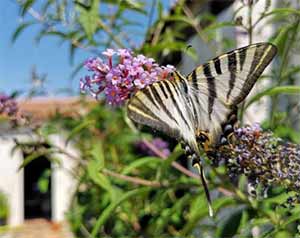Garden of Grace
A place for dawdling spirits and flutter-bys
by Claire Hagen Dole
 For several glorious weeks each summer, my backyard is visited by western tiger swallowtails. Gliding through on large yellow-and-black wings, these showy butterflies stop to feed on a garden planted especially for them. Common in the Northwest, they'd fly through even if my yard offered nothing but grass and nondescript juniper bushes, but now they linger on the flowers and shrubs that replaced the lawn a couple of years back.
For several glorious weeks each summer, my backyard is visited by western tiger swallowtails. Gliding through on large yellow-and-black wings, these showy butterflies stop to feed on a garden planted especially for them. Common in the Northwest, they'd fly through even if my yard offered nothing but grass and nondescript juniper bushes, but now they linger on the flowers and shrubs that replaced the lawn a couple of years back.
What prompted me to make room among my vegetables, herbs, fruit trees, and berries for a garden to attract butterflies? I'm enthralled with their beauty and grace, qualities that have led many cultures to equate butterflies with the human soul. And the more I learn about them, the more curious I become about all the other creatures that populate my small world and what they need to survive.
Butterflies, bees, ladybugs, dragonflies, and beetles all suffer from exposure to commonly used pesticides. But butterflies show such sensitivity that scientists view them as indicator species for pesticide overuse. Even B.t. (Bacillus thuringiensis), considered a safe organic pest control, destroys butterfly larvae along with the gypsy moth and other pests it targets.
More deadly, however, is the suburban sprawl that gobbles up natural habitat. The average gardener can make a real difference in the preservation of local species by thinking of a yard as a link in a wildlife corridor, enabling butterflies to find food and shelter as they roam in search of mates.
Ready to get out that shovel? First, find a sunny, sheltered place. Large rocks or a stone wall make great basking spots. It's a plus if you can put your garden near a window, for better butterfly watching.
Fragrance and color will draw in a passing butterfly; plant flora in masses for greatest effect. Access to the nectar is important--showy double blooms and hybrids don't provide good perches or feeding sources. Some longer-lived butterflies supplement their diet with decayed fruit, tree sap, animal scat, even carrion. Leave a few apples under the tree and watch for the red admiral as it darts on orange-banded black wings.
In choosing plants, start with native species. You'll be helping to preserve the biodiversity of your region. You'll also look like a terrific gardener, because native plants are adapted to the climate and soil.
The most potent butterfly attractant, however, is likely to be a butterfly bush (Buddleia davidii), a native of China. Well-behaved dwarf varieties have been developed for small gardens. Other tried-and- true nectar plants include lantana, liatris, scabiosa, Mexican sunflower, verbena, joe-pye weed, zinnia, marigold, cosmos, phlox, butterfly weed, aster, coneflower, black-eyed Susan, blanketflower, yarrow, bee balm, lavender, sage, and oregano. Watch your visitors the first summer and you'll learn what works best in your area.
While adult butterflies will sip nectar from many flowers, egg-laying females may be looking for one specific plant to feed their offspring. Your garden may already provide fennel, dill, and parsley for black or anise swallowtails--two dark beauties with blue and yellow hind-wing patterns and broad yellow bands, respectively. Try lupine for the tiny blues, violets for fritillaries (whose orange wings are patterned with zigzags and dots), and snapdragons for buckeyes (brown with large "eyespots.") Check a guidebook for preferred native host plants for butterflies in your region.
Butterflies frequent the boundaries of habitat zones, like the spot where a meadow meets the trees. The males, patrolling for a mate, can dart into the shrubbery for safety. Wood or brush piles also give shelter in bad weather or during winter months. Provide a patch of wet sand or dirt for male butterflies, who gather to sip mineral-rich water--a behavior called "puddling."
From my lawn chair next to the butterfly bush I've watched small dramas and seen breathtaking beauty. I've been beckoned by my child's excited voice when a new winged visitor arrives for the season. And this legacy to her generation, as well as my humble contribution to butterfly conservation, enhances the pleasure of keeping a garden for these "flying flowers."
Article by Claire Hagen Dole, Publisher/editor of Butterfly Gardeners' Quarterly. Originally appeared in Sierra Club Magazine. Reprinted with permission of the author.





